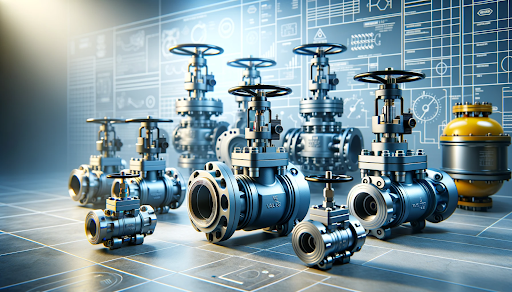Maximizing System Control with High-Performance Control Valves
Maximizing System Control with High-Performance Control Valves
Blog Article

Maximize Power Financial Savings and Comfort With Advanced Structure Automation Controls
In the realm of contemporary architecture and center management, the combination of advanced structure automation manages stands as an essential development. By using the power of automation, structures can adapt, respond, and advance in ways that were once unimaginable.
Energy Effectiveness Conveniences
Energy effectiveness benefits can considerably minimize energy usage and operational prices in structures. Energy-efficient systems, such as sophisticated building automation controls, can optimize the usage of sources like lights, home heating, and cooling, leading to reduced power expenses over time.
Moreover, boosted power effectiveness can prolong the lifespan of structure devices and systems. By operating a lot more efficiently, a/c systems, lighting components, and other building components experience much less damage, causing reduced maintenance and substitute prices. In addition, energy-efficient structures typically regulate higher building worths and rental rates, providing long-lasting financial benefits to owners.
Furthermore, energy efficiency can enhance resident comfort and efficiency. Appropriately controlled indoor atmospheres with ideal lights and thermal conditions develop an even more favorable and positive workspace, causing enhanced employee fulfillment and efficiency. In general, the energy performance advantages related to sophisticated structure automation controls are complex, encompassing expense financial savings, environmental stewardship, and passenger health.
Enhanced Comfort Control
Enhancing convenience control in structure environments requires a sophisticated assimilation of innovative automation systems for optimum passenger health. By using advanced structure automation controls, centers can tailor the interior setting to meet the particular demands and choices of occupants. control valves.
By including these advanced controls, buildings can not only enhance comfort however likewise boost power efficiency by enhancing system procedures based on real tenancy and use patterns. Inevitably, focusing on owner comfort through advanced automation systems leads to a more pleasurable and healthier indoor atmosphere.
Operational Performance Improvements

Furthermore, the implementation of real-time surveillance and analytics tools enables structure operators to recognize energy inefficiencies and functional anomalies immediately. By continuously keeping track of power usage patterns and system efficiency metrics, modifications can be made in real-time to optimize power consumption and make sure peak operational effectiveness. control valves. Additionally, integrating need response methods into building automation controls can better improve functional efficiency by dynamically changing power use based on grid conditions and rates signals
Indoor Climate Optimization
Effective interior environment optimization is a fundamental element of structure automation controls, making sure owners' comfort and well-being while taking full advantage of power savings. By utilizing sophisticated sensors and controls, developing automation systems can continually keep track of and change temperature, humidity levels, air quality, and ventilation to create an ideal indoor atmosphere. Preserving comfy and consistent problems not just boosts owner complete satisfaction however additionally enhances performance and total health.
Interior environment optimization additionally plays an essential role in energy performance. By fine-tuning home heating, air conditioning, and air flow systems based on real-time data and tenancy patterns, constructing automation controls can dramatically lower power consumption - control valves. Implementing approaches such as demand-controlled ventilation and thermal zoning can help decrease power waste while guaranteeing that each area of the structure gets the required conditioning.
Lasting Atmosphere Creation
Structure automation manages not article source only optimize indoor environment problems for energy effectiveness and resident comfort yet additionally lay the structure for producing a sustainable environment through strategic monitoring of systems and sources. By incorporating innovative structure automation innovations, such as sensing units, actuators, and smart software program, centers can keep track of and adjust energy usage in real-time to reduce waste and minimize their carbon footprint. These systems enable anticipating upkeep, determining potential concerns before they rise and enhancing tools performance to enhance longevity and efficiency.
In addition, lasting environment production extends beyond power management to encompass water conservation, waste reduction, and indoor air quality enhancement. Structure automation controls can control water use, spot leaks, and ensure proper waste disposal techniques, adding to total sustainability efforts. In addition, by keeping track of and controlling air flow and filtering systems, these innovations boost owner wellness and performance while lowering power intake related to HVAC operations.
Conclusion
In final thought, advanced building automation controls offer substantial advantages in regards to power cost savings, comfort control, operational effectiveness, interior environment optimization, and creating a lasting setting. By executing these controls, buildings can achieve optimal performance while minimizing power intake and improving resident convenience. It appears that the usage of innovative automation innovation is vital in enhancing structure efficiency and creating an extra sustainable future.
Power effectiveness advantages can considerably decrease power usage and operational costs in structures. In general, the energy efficiency benefits associated with advanced structure automation controls are complex, incorporating price savings, environmental stewardship, and owner wellness.
In addition, integrating demand advice response strategies right into structure automation controls can even more boost functional efficiency by dynamically adjusting power use based on grid conditions and pricing signals.
Building automation controls not just enhance interior climate problems for energy efficiency and occupant convenience however likewise lay the foundation for creating a sustainable setting through calculated monitoring of resources and systems.In conclusion, progressed structure automation manages offer considerable benefits in terms of energy cost savings, comfort control, operational performance, interior climate optimization, and producing a lasting setting.
Report this page